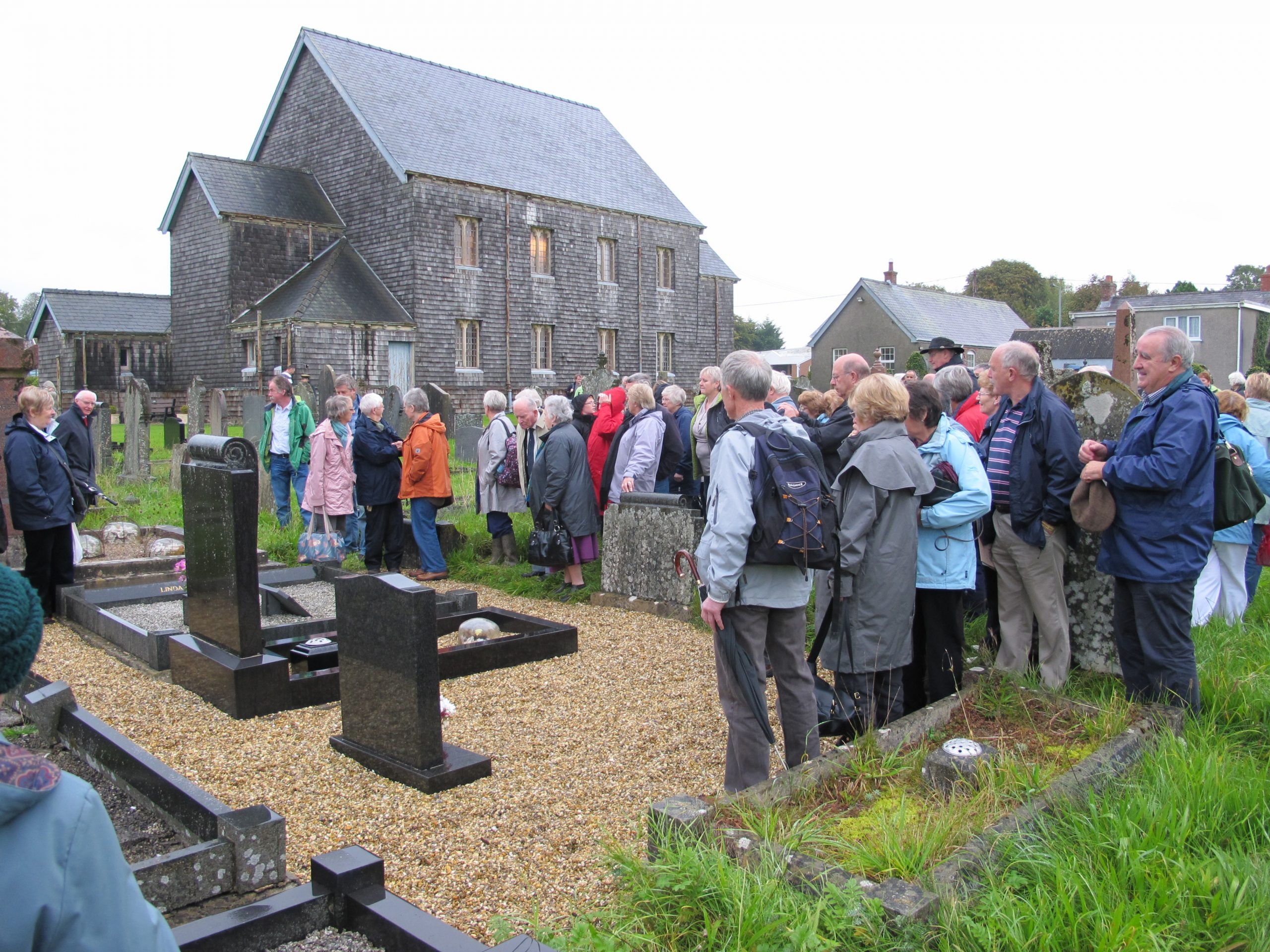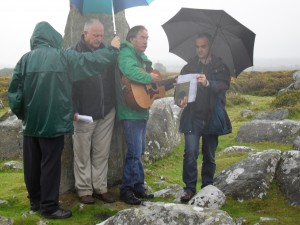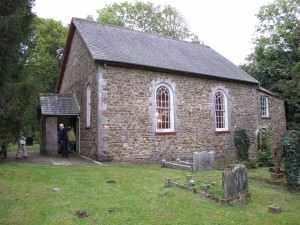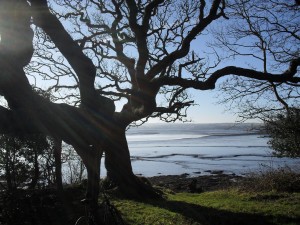
On Saturday, 24 September 2011, over 80 pilgrims were led to various places in Pembrokeshire associated with the life of Waldo Williams. The crew met at Blaenconin Chapel where Waldo became a member following baptism by total immersion as a 16 year old in 1920, and hence he received that astonishing letter from his father expounding the seriousness of the mantle he had taken on.
Following a short period of silence in the manner of the Quakers form of worship, the current minister, Rev Huw George led the congregation in prayer. He then made the startling announcement that plans were afoot to establish a Waldo Centre on the chapel grounds. Before leaving the chapel, crowned bard Eirwyn George related his unexpected part in Waldo’s funeral when he wore a red tie. When he arrived at Narberth County School that particular morning he was summoned to represent the school at the funeral of one of its most distinguished former pupils.
He had no time to go home to wear appropriate mourning clothes. And when Eirwyn arrived at the chapel gates he was further summoned, by W. R. Evans, to be one of the bearers. As he ushered the large throng from the chapel to the cemetery nearby to pay homage at Waldo’s family grave, Cerwyn Davies, chairman of the Waldo Society, and one of the pilgrimage leaders, suggested that the theme for the day should be the line, ‘Cod ni i fro’r awelon pur / O’n hogofau’ (Lift us to the hills of the pure breezes / From our caves), from the poem ‘Ar Weun Cas’mael’ (On Puncheston Moor).  Because of the severity of the weather others were soon quoting other lines composed by Waldo such as, “Yr oedd rhyw ffynhonnau’n torri tua’r nefoedd / Ac yn syrthio’n ôl a’u dagrau fel dail pren” (The fountains burst up towards heaven, till,/ Falling back, their tears were like the leaves of a tree) from the poem, ‘Mewn Dau Gae’ (In Two Fields) by the time they had reached Parc y Blawd and Weun Parc y Blawd (Flour Meadow Field and Flour Field) in the company of Vernon Beynon, Cross Farm.
Because of the severity of the weather others were soon quoting other lines composed by Waldo such as, “Yr oedd rhyw ffynhonnau’n torri tua’r nefoedd / Ac yn syrthio’n ôl a’u dagrau fel dail pren” (The fountains burst up towards heaven, till,/ Falling back, their tears were like the leaves of a tree) from the poem, ‘Mewn Dau Gae’ (In Two Fields) by the time they had reached Parc y Blawd and Weun Parc y Blawd (Flour Meadow Field and Flour Field) in the company of Vernon Beynon, Cross Farm.
Vernon explained how Waldo and his parents would spend hours upon hours sitting underneath a formidable oak tree reading and lost in their thoughts. National bard, Mererid Hopwood, explained how from the experience of ‘seeing the sea of light’ at that spot when he was a teenager that Waldo later wrote the poem, ‘Mewn Dau Gae’. She then read the poem. By the time Puncheston was reached the weather had abated as the crew visited the old school building where Waldo spent a short period as a temporary head teacher before he moved to the Lleyn Peninsula with his wife, Linda. National bard, Aled Gwyn, explained the background of the poem ‘Ar Weun Cas’mael’ (On Puncheston Moor) and the presence of the Trecwn armaments depot nearby which wounded Waldo’s soul.

He read the poem with profundity. At Puncheston as well, in the new school building, Peter John read the poem ‘Fel Hyn y Bu’ (This is how it was) while Eirwyn George explained its background when Waldo was mistaken for a German spy in the neighbourhood during the Second World War. Eirwyn knew all the protagonists of the saga. Following lunch at Allt-yr-afon Hotel, Wolfscastle, and on arriving at St David’s Square the sun shone brightly. There by the Celtic cross, Emyr Llewelyn related the epic story of Waldo’s general election campaign on behalf of Plaid Cymru in 1959. By launching and closing his campaign in the cathedral city Waldo acknowledged the significance of St David’s as the cradle of Welsh Christianity. A long bus journey followed to Milford Haven, and a period of silence at the Quakers Meeting House where Waldo would regularly worship among the brethren. Another feast had been prepared and Waldo’s presence was to be seen throughout the building.

The two buses drove through Haverfordwest before turning from the A40 towards Millin Chapel where Waldo would shelter in the early hours before venturing towards the confluence of the Cleddau nearby to witness daybreak. But he was mistaken for a tramp and lest he drew other similar vagrants it was decided to lock the chapel door overnight. Hefin Wyn explained that the hours spent at Millin C M Chapel was an essential part of Waldo’s worship before he took part in the sublime experience of daybreak, which he saw as an act of resurrection anew. Most probably, he sought the same quality of light he saw at Parc y Blawd and Weun Parc y Blawd as a youngster. At the river’s edge, Alun Ifans, the trip organiser and fellow guide, mentioned how the revelatory light had also enticed the artist Graham Sutherland. Alun emphasised the magic associated with the locality before Wyn Owens read the poem ‘Y Dderwen Gam’ (The Crooked Oak).
The two coaches then took the pilgrims back to the morning’s starting point at Llandysilio. Among the pilgrims were Tania George from Pennsylvania, USA, who is responsible for the Peace Collection at Swarthmore College, which contains much information about Waldo, and Keith Warren from Watford, Chairman of the London Welsh Male Voice Choir, which never terminates a concert without a rendition of Eric Jones’ arrangement of the poem ‘Tangnefeddwyr’ (Peacemakers) written by Waldo.
